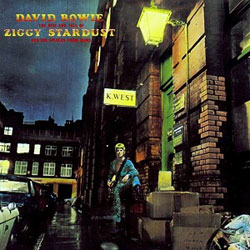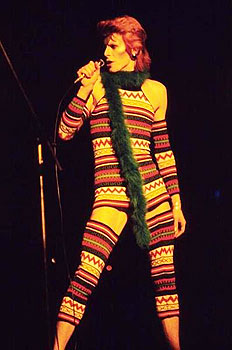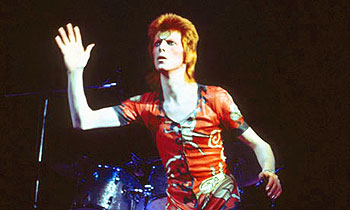Ground Control To Major Stardust: Ziggy’s Tale
Published on May 30th, 2011 in: Climb Onto The Nearest Star, Issues, Music, Science Fiction |“I’m just a space cadet. He’s the commander.”
—Bowie fan, 1973

Perhaps the quintessential science fiction concept album (certainly one of the most famous), The Rise and Fall of Ziggy Stardust and the Spiders from Mars was released in June of 1972. Although its grip on a unified story is loose when viewed by the music alone, like the best concept albums, its songs are universal enough to work on their own as well as within the world of the album. The true Ziggy experience comes from including external sources as well, seeing it as a work of theater.
David Bowie may not have had a cohesive Ziggy story when he began the album, but by the time it was finished, he had adopted the fictional character as his own, and fleshed out the tale. And like the best stories, it cannot be pinned down exactly. Bowie himself changed elements to suit him, depending on his mood.
Portraying the titular character, Bowie took pains to act as otherworldly as possible. Striking stage costumes from Japanese designer Kansai Yamamoto coupled with the singer’s naturally thin physique and mime training produced a vision that few rock fans had ever seen. For a while, Bowie (or Ziggy) wore an “astral sphere” on his forehead to further distance himself from earthly reality.
In its most simplified form, the album depicts a messianic tale with a science fiction twist, about an alien who comes to earth to bring salvation. He chooses rock music over religion as the new way of spreading his message, and becomes famous. However, plans don’t always work out the way they’re expected to, and the spaceman is brought low.

In the song “Five Years,” the stage is set. Earth is “really dying,” having but five years left. The song describes people’s reactions to the news, from the anchorman’s tears to a young girl beating up “tiny children.”
The next song, “Soul Love,” divides up the emotion into three distinct types: that for the departed (stone love), that of romance (new love), and religious worship (soul love). Ziggy aims to become the object of love, which has been unfulfilling and destructive until now, in the “church of man” he names in the following track.
“Moonage Daydream” is Ziggy striding onto the stage. In fact, Bowie would introduce the number as “a song written by Ziggy” while on tour. Science fiction terms are strewn about: “raygun,” “space invader,” “space face.” This is an alien being who is self-confident and swaggering.
First contact with earthlings is made in “Starman,” through the appropriate medium of radio. Two kids compare notes on what they know of the strange being orbiting the doomed planet. Ziggy is hesitant, though, afraid that his arrival might “blow [their] minds.” Intentionally mimicking the song “Somewhere Over the Rainbow” in its chorus, this is a hopeful song.
“It Ain’t Easy,” the only cover song on the album, is a bit harder to place into the myth. It can be interpreted as the Starman’s struggle to become famous, or perhaps even a song performed by Ziggy on stage. A country-rock number, it’s a pleasant enough tune to end side one.
Marc Bolan of the band T. Rex was the inspiration for “Lady Stardust,” but within the Ziggy concept, it represents the androgynous alien rock messiah as seen by his audience. “People stared at the makeup on his face,” indeed.
A bit out of sequence, “Star” is Ziggy’s mission statement. Originally titled “Rock N’ Roll Star,” it’s a headlong rush into fame, or at least the desire for it. In order to reach the masses of kids who have given up on religion, music is the way.

Fame and adulation have finally arrived in “Hang On To Yourself,” which is rock and roll church in full swing. Kids are “praying to the light machine” at the concert, and the feeling is mutual: “You’re the blessed, we’re the Spiders from Mars.” Ziggy and his band are preaching the good word.
“Suffragette City” is another song from the Spiders, with its famous “wham bam, thank you ma’am” tag line. A Clockwork Orange is referenced as the singer warns his “droogie” not to stick around and spoil the party. The third hard rocker in a row, it gives the impression that the rock star has gone perhaps too far, that the end is near.
“Rock N’ Roll Suicide” is that end. The now-jaded and worn out Ziggy sings about running out of time. Bowie described it as “a declaration of the end of the effect of being young,” and the weary beginning is just that. Slowly the song builds, culminating in passionate, ecstatic screams of “You’re not alone! Gimme your hands!” as Ziggy bonds with his audience. We bear witness to a ritual sacrifice, the death of the space messiah at the hands of his worshippers.
Fascinated with the idea of space, of The Other, of religion and fame, David Bowie crafted his own mythological hero in Ziggy. He came to us with the best of intentions, but was eventually consumed by the very people he tried to save. Bowie was to give Ziggy a reprise of sorts in the 1976 movie The Man Who Fell to Earth, in which an alien visitor is corrupted and destroyed by the culture in which he finds himself.
While other glam-rock bands of the time were experimenting with gender roles, David Bowie was moving beyond his own planet. Nearly 40 years later, The Rise and Fall of Ziggy Stardust and the Spiders from Mars still feels like space-age storytelling.
Time limit is exhausted. Please reload the CAPTCHA.